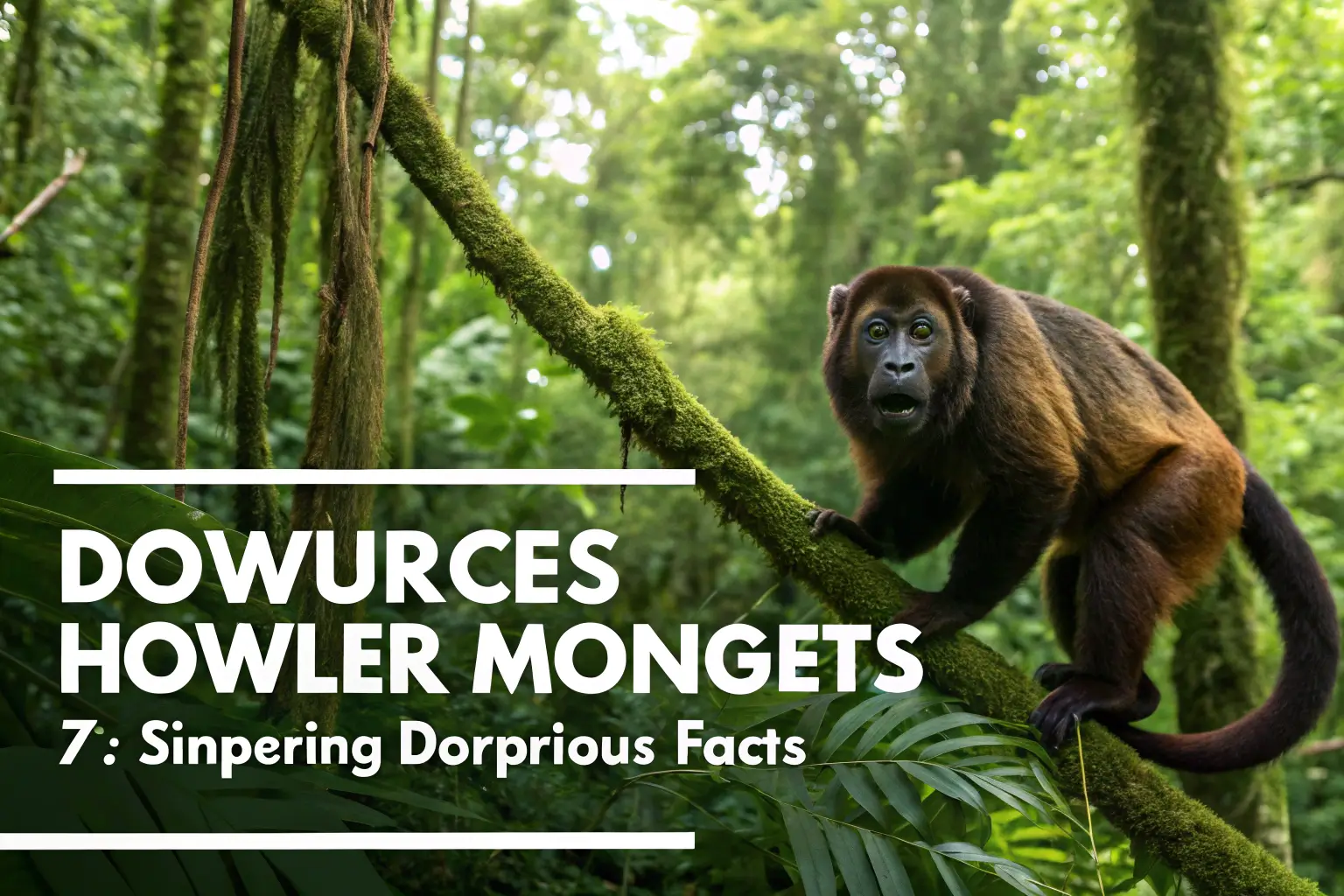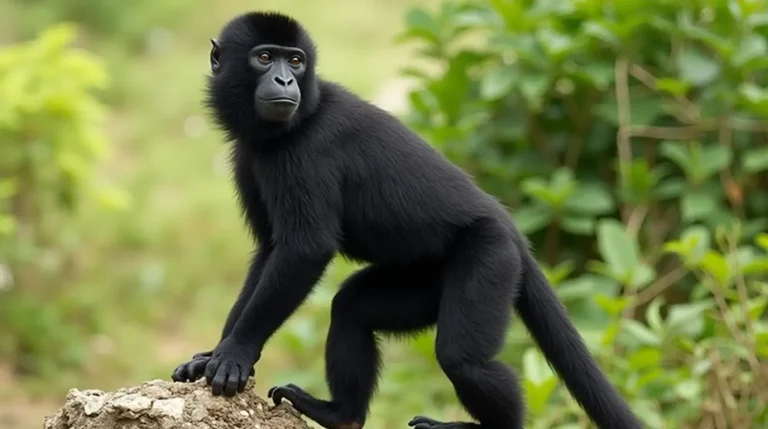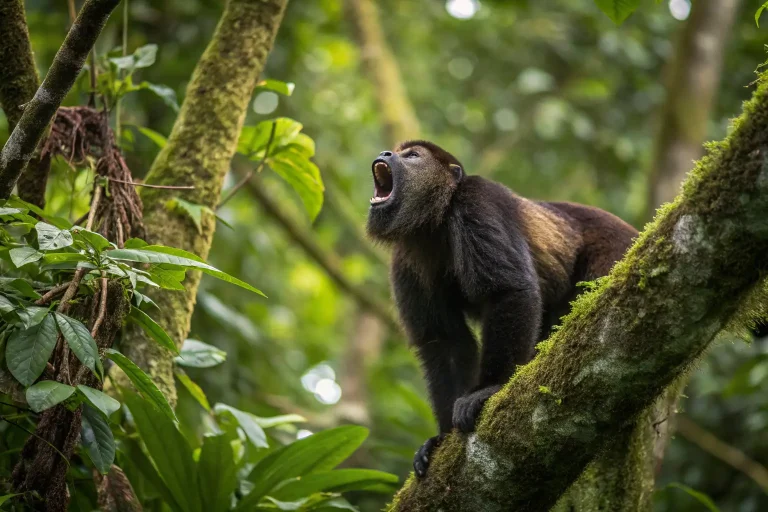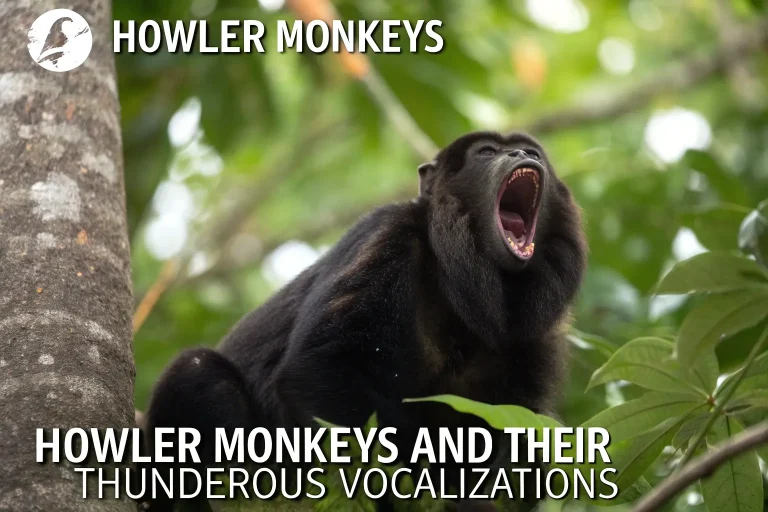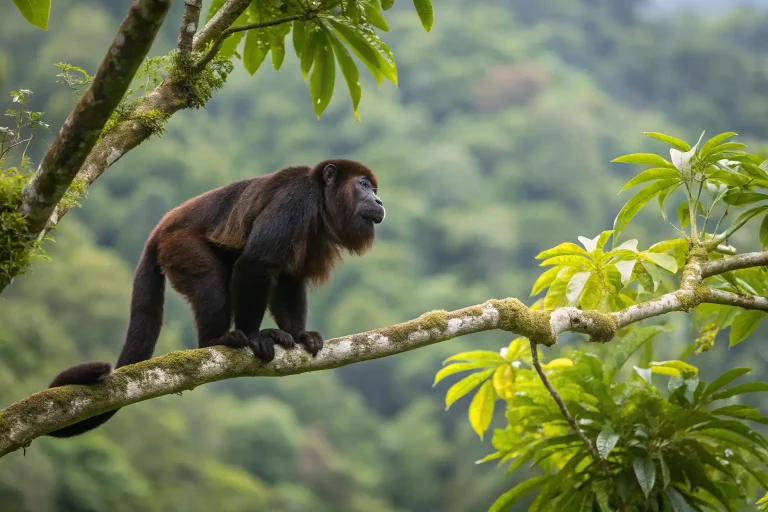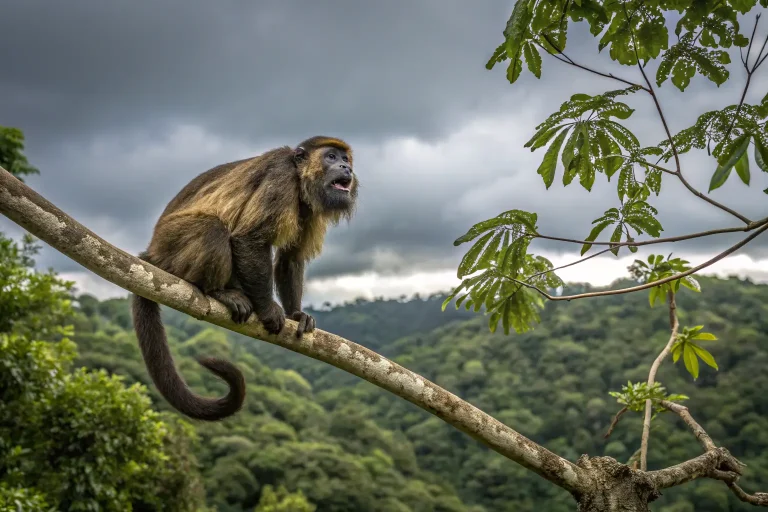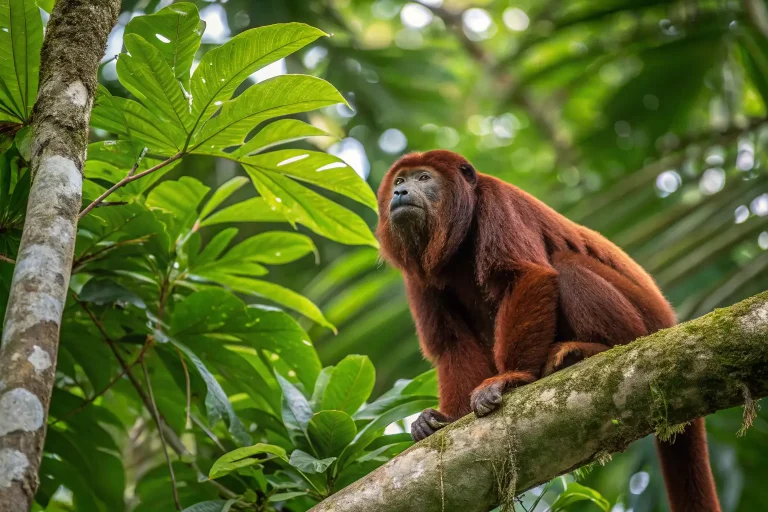Are Howler Monkeys Dangerous? 7 Surprising Facts Revealed!
Introduction
The unmistakable roar of howler monkeys reverberates through the rainforest canopy, carrying for miles and often startling unsuspecting visitors. As one of the loudest land animals on Earth, these vocal primates command attention and sometimes provoke fear. But are howler monkeys dangerous to humans, or is their intimidating call simply nature’s way of establishing territory?
Understanding these remarkable creatures is essential not only for travelers venturing into their habitat but also for conservation efforts and appreciating the delicate balance of rainforest ecosystems. While their thunderous calls might suggest aggression, the reality of howler monkey behavior often contradicts first impressions.
Before we unravel the truth about their potential danger, consider this: a howler monkey’s roar can be heard up to three miles away through dense jungle, despite the animal itself weighing only about 15 pounds. This remarkable ability sets the stage for our exploration into one of the New World’s most fascinating primates.
Species Overview
Scientific Classification
Howler monkeys belong to the family Atelidae and genus Alouatta. Scientists recognize 15 species of howler monkeys, including the mantled howler (Alouatta palliata), the red howler (Alouatta seniculus), and the black howler (Alouatta caraya). Each species has adapted to different regions throughout Central and South America.
Physical Characteristics
Howler monkeys typically weigh between 10-22 pounds (4.5-10 kg), with males generally larger than females. They range from 22-36 inches (56-92 cm) in body length, with an additional tail length of 23-36 inches (58-91 cm). Their prehensile tails function as a fifth limb, providing stability while moving through trees.
Their most distinctive physical feature is the enlarged hyoid bone in their throat, which forms a resonating chamber enabling their characteristic howl. Coloration varies by species, ranging from golden and red to black and brown, with some species showing sexual dimorphism.
Subspecies and Variations
The mantled howler monkey alone has seven recognized subspecies, each adapted to specific regions. The Mexican mantled howler (A. p. mexicana), for instance, has a more restricted range and faces greater conservation challenges than other subspecies.
Regional variations extend beyond appearance to behavior, diet, and social structure. Some populations have adapted to fragmented habitats, while others require pristine rainforest conditions to thrive.
Habitat and Distribution
Natural Habitat
Howler monkeys are arboreal creatures, spending nearly their entire lives in the upper canopy of tropical and subtropical forests. They prefer mature forests with tall trees and continuous canopy coverage, allowing them to move through their territory with minimal ground contact.
These primates rarely descend to the forest floor, making their homes 10-160 feet (3-49 meters) above ground. Their preference for higher elevations minimizes contact with ground predators and human interaction, which addresses part of the question of whether howler monkeys are dangerous to people—their lifestyle naturally limits confrontation opportunities.
Geographic Range
Howler monkeys inhabit a broad range across Latin America, from southern Mexico through Central America and into central South America, including parts of Brazil, Bolivia, Paraguay, and northern Argentina. Different species have adapted to various forest types, including rainforests, cloud forests, and even semi-deciduous forests.
The black howler can thrive in more disturbed habitats, while the mantled howler requires more intact forest systems. This distribution across diverse ecosystems demonstrates their adaptability despite specific habitat requirements.
Adaptations
Besides their famous vocal adaptations, howler monkeys have evolved several survival strategies:
- Prehensile tails that can support their entire body weight
- Specialized molars for grinding tough leaves
- A digestive system capable of extracting nutrients from fibrous vegetation
- Color vision that helps identify ripe fruits
- Energy conservation behaviors to cope with their low-energy diet
Their sedentary lifestyle—sometimes resting for up to 80% of their day—reflects adaptation to a leaf-heavy diet that provides limited energy, influencing their generally peaceful behavior patterns.
Diet and Feeding Habits
What Howler Monkeys Eat
Howler monkeys are primarily folivores (leaf-eaters), with leaves constituting 50-70% of their diet. However, they’re opportunistic feeders who also consume:
- Fruits (especially when seasonally abundant)
- Flowers
- Nuts and seeds
- Young shoots and buds
Their diverse diet helps answer the question of whether howler monkeys are dangerous—since they don’t compete with humans for food resources and don’t hunt prey, there’s little reason for food-related aggression toward people.
Foraging Behavior
Howlers typically feed in the early morning and late afternoon, avoiding the midday heat. Their feeding strategy involves:
- Moving slowly through their territory
- Selecting young, tender leaves when available
- Focusing on high-energy fruits when in season
- Remaining within a relatively small home range (3-60 hectares depending on the species)
Unlike some more agile monkeys, howlers move methodically through the canopy, conserving energy while searching for appropriate food sources.
Dietary Adaptations
Their specialized digestive system features an enlarged cecum that houses symbiotic bacteria, allowing them to break down cellulose in leaves. This adaptation enables them to extract nutrients from mature leaves when preferred food sources are scarce.
Interestingly, howlers select leaves based on protein content rather than fiber content, showing sophisticated nutritional awareness. Some species have been observed eating clay from river banks, likely to neutralize toxins in their leaf-heavy diet—a behavior called geophagy.
Behavior and Social Structure
Social Organization
Howler monkeys live in troops ranging from 5 to 19 individuals, typically consisting of:
- One to three adult males
- Multiple adult females
- Their offspring
Social dynamics vary by species, with some practicing male dispersal (where young males leave their birth group) and others following female dispersal patterns. The black howler monkey forms groups with a single dominant male, while mantled howlers maintain multiple males within the troop.
When considering are howler monkeys dangerous, their social structure offers clues—aggression is typically limited to competitive interactions between males during mating season or territorial disputes with other troops.
Communication
The iconic howl serves multiple purposes:
- Territorial announcement to neighboring groups
- Group coordination when separated
- Response to potential threats
- Dawn chorus that may regulate spacing between groups
Males typically produce the loudest calls, but females also participate in group choruses. Beyond vocalizations, howlers communicate through:
- Body postures and facial expressions
- Scent marking
- Physical contact including grooming, which strengthens social bonds
Mating and Reproduction
Howler monkeys don’t have a specific breeding season, reproducing year-round when conditions permit. Key reproductive characteristics include:
- Gestation period of about 6 months
- Single offspring (twins are extremely rare)
- Sexual maturity reached at 3-5 years
- Infant care primarily by the mother, with limited male involvement
- Lifespan of 15-20 years in the wild, with females occasionally living longer than males
Young howlers stay with their mothers for about two years, gradually gaining independence while learning essential survival skills through observation.
Conservation Status
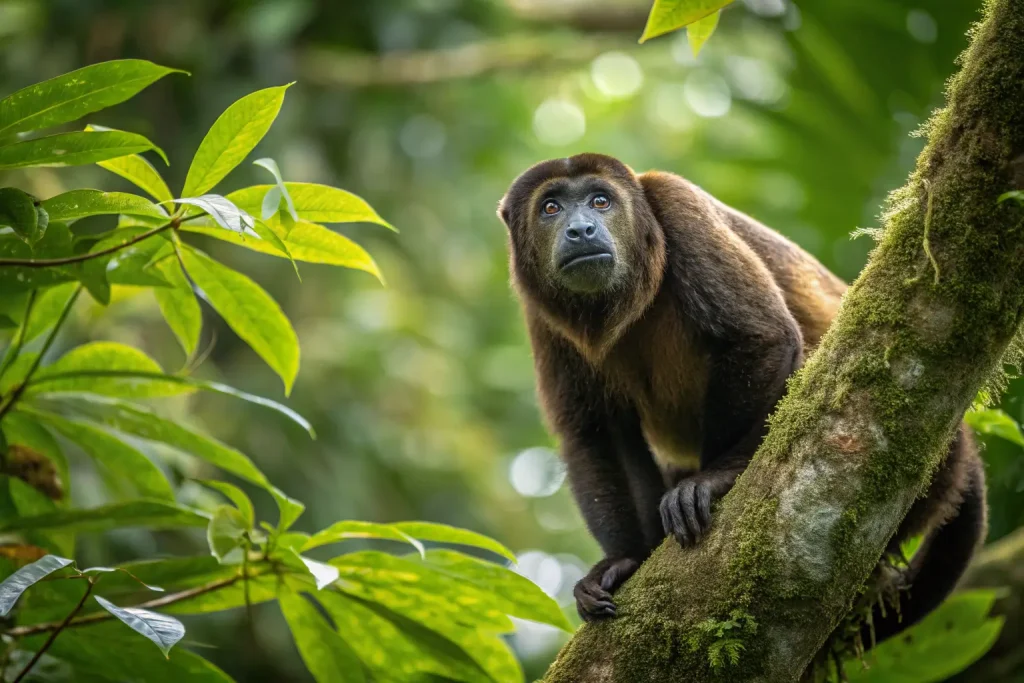
Endangerment Level
According to the International Union for Conservation of Nature (IUCN), howler monkey species face varying levels of threat:
- The Guatemalan black howler (Alouatta pigra) and Mexican howler (A. palliata mexicana) are classified as Endangered
- The brown howler (A. guariba) is Vulnerable
- The red howler (A. seniculus) and mantled howler (A. palliata) are of Least Concern, though some populations are declining
Despite some species maintaining stable populations, localized extinctions have occurred throughout their range, indicating conservation concern.
Threats
Major threats to howler monkeys include:
- Habitat destruction through deforestation and agricultural expansion
- Forest fragmentation isolating populations
- Hunting for bushmeat in some regions
- Capture for the illegal pet trade
- Yellow fever outbreaks that can decimate local populations
- Infrastructure development (roads, hydroelectric dams)
Their specialized diet and relatively limited mobility make them particularly vulnerable to habitat changes.
Conservation Efforts
Several conservation initiatives focus on howler monkeys:
- Protected area designation throughout their range
- Habitat corridor creation connecting fragmented forests
- Community-based conservation programs engaging local stakeholders
- Ecotourism projects providing economic alternatives to deforestation
- Reintroduction programs in areas of local extinction
- Research and monitoring to identify priority conservation areas
These efforts highlight the importance of howler monkeys as flagship species for Neotropical forest conservation.
7 Surprising Facts About Howler Monkeys
1. They’re Not Actually Dangerous to Humans
Despite their intimidating roars, howler monkeys are not dangerous to people. These primates are generally shy and retreat rather than confront humans. Unlike some primate species, they:
- Don’t raid crops or human settlements
- Show little to no aggression toward people
- Prefer avoiding contact entirely
- Have no documented attacks on humans in the wild
Their fearsome reputation stems purely from their vocalizations, not their behavior.
2. Their Calls Are Louder Than Rock Concerts
Howler monkey vocalizations can reach 140 decibels—louder than a rock concert (115 dB) and approaching the pain threshold for human ears (125 dB). This makes them the loudest land animals in the Americas and among the loudest on Earth.
3. They’re Extraordinarily Energy-Efficient
Howlers have the lowest energy expenditure of any non-hibernating mammal their size. They may spend up to 70% of their day resting and digesting, moving less than a mile per day—an adaptation to their low-calorie, leaf-based diet.
4. They Have Remarkable Color Vision
Unlike many mammals with limited color perception, howler monkeys possess trichromatic vision similar to humans. This adaptation helps them identify ripe fruits and nutritious young leaves, giving them a survival advantage in complex forest environments.
5. Their Digestive System Houses Multiple Fermentation Chambers
Howler monkeys have evolved specialized digestive systems with multiple chambers that house beneficial bacteria. This complex gut microbiome allows them to break down tough cellulose in mature leaves, extracting nutrients that would be inaccessible to many other primates.
6. They’re Ecological Engineers
As seed dispersers, howler monkeys play a crucial role in forest regeneration and biodiversity maintenance. A single howler troop can disperse over 300,000 seeds annually, spreading more than 60 different plant species throughout their territory.
7. Their Societies Show Gender Role Flexibility
While many primate species have rigid social structures, howler monkeys display surprising flexibility in gender roles. In some troops, females actively participate in territorial defense alongside males, and when male numbers are low, females sometimes take over leadership positions within the group.
Encountering Howler Monkeys Safely
Observing in the Wild
For those wondering “are howler monkeys dangerous to encounter,” here are guidelines for safe, respectful observation:
- Maintain a distance of at least 15-20 meters from troops
- Avoid direct eye contact, which some primates perceive as threatening
- Move slowly and quietly to avoid startling them
- Never feed wild howler monkeys, as this alters natural behaviors
- Join guided tours with experienced naturalists when possible
- Be prepared for early morning viewing when they’re most active
Photography Tips
Capturing these charismatic primates requires:
- Telephoto lenses (at least 200mm) to maintain safe distance
- Fast shutter speeds to compensate for low light conditions
- Patience, as howlers may remain motionless for extended periods
- Early morning shooting for optimal activity and lighting
- Awareness of their predictable movements during feeding times
What to Do If You Encounter Them Closely
In the unlikely event of a close encounter:
- Stay calm and avoid sudden movements
- Back away slowly without turning your back
- Never attempt to touch or feed them
- Keep children close and controlled
- Respect their space and natural behaviors
Remember that howler monkeys are not dangerous when treated with appropriate respect for their wild nature.
Role in the Ecosystem
Ecological Importance
Howler monkeys function as keystone species in Neotropical forests through several ecological contributions:
- Seed dispersal: Their consumption and subsequent defecation of seeds helps maintain forest diversity and structure
- Pollination: Flower feeding occasionally transfers pollen between plants
- Folivory: Leaf consumption influences forest composition by affecting which tree species thrive
- Prey base: They occasionally serve as prey for large raptors and felids
Their presence or absence serves as an indicator of overall forest health and ecosystem functioning.
Impact of Population Decline
When howler populations decline or disappear, cascading ecological effects include:
- Reduced seed dispersal rates for certain plant species
- Altered forest composition favoring wind-dispersed plant species
- Changed dynamics among remaining primate species
- Loss of a key food source for predators like harpy eagles
- Diminished bioacoustic richness affecting forest communications
Research in fragmented forests demonstrates that areas without howlers show measurable differences in vegetation composition within decades.
Conclusion
After examining the behavior, habitat, and interactions of howler monkeys, we can confidently answer the central question: are howler monkeys dangerous? The evidence clearly shows they pose virtually no threat to humans. Despite their powerful vocalizations that might suggest aggression, these remarkable primates are peaceful folivores that prefer avoiding human contact entirely.
The misconception about their danger likely stems from their impressive vocal abilities rather than actual behavior. In reality, howler monkeys face far more danger from human activities—deforestation, hunting, and habitat fragmentation—than they could ever pose to people.
As we’ve discovered through these seven surprising facts, howler monkeys contribute significantly to their ecosystems while embodying remarkable adaptations for survival. Their conservation remains important not just for maintaining biodiversity but for preserving the complex ecological relationships that sustain tropical forests.
Next time you hear that distinctive howl echoing through the rainforest, remember: that booming sound represents not a threat, but a fascinating evolutionary adaptation that has helped these gentle primates thrive for millions of years.
Frequently Asked Questions
Do howler monkeys attack humans?
No, howler monkeys do not typically attack humans. They’re generally shy, non-aggressive primates that prefer to avoid human contact. When confronted, their typical response is to retreat rather than attack. There are virtually no documented cases of howler monkeys attacking people in the wild.
Why are howler monkeys so loud?
Howler monkeys have evolved specialized vocal anatomy—including an enlarged hyoid bone that forms a resonating chamber—allowing them to produce their distinctive calls. These vocalizations serve to communicate with distant group members, defend territory from other troops, and possibly deter predators without physical confrontation. Their remarkable volume helps them maintain spacing between groups without direct competition.
Can you keep a howler monkey as a pet?
No, howler monkeys should never be kept as pets. They require specialized diets, complex social structures, and large arboreal territories to thrive. Additionally, keeping them as pets is illegal in most countries without proper permits, contributes to wildlife trafficking, and often results in psychological damage to the animals. Their specific environmental and social needs simply cannot be met in domestic settings.
What predators do howler monkeys have?
Howler monkeys face predation primarily from large raptors like harpy eagles and crested eagles. Large cats including jaguars and pumas may occasionally prey on them when they venture lower in the canopy. Boa constrictors and other large snakes also represent threats, particularly to younger individuals. Their treetop lifestyle minimizes but doesn’t eliminate predation risk.
How far can you hear a howler monkey?
Howler monkey calls can travel up to 3 miles (5 kilometers) through dense forest. Their vocalizations rank among the loudest produced by any land animal, reaching up to 140 decibels at close range. This remarkable carrying capacity allows troops to communicate effectively across their forest territory without visual contact.
Are howler monkeys endangered?
Some howler monkey species face significant conservation challenges. The Guatemalan black howler and Mexican howler are classified as Endangered on the IUCN Red List. Other species like the brown howler are considered Vulnerable, while some maintain stable populations and are listed as Least Concern. Conservation status varies considerably by species and geographic location.
What’s the difference between howler monkeys and spider monkeys?
While both belong to the same family (Atelidae), these primates differ significantly. Howler monkeys have stockier builds, shorter limbs, and are less agile than spider monkeys. Spider monkeys have extraordinarily long limbs and tails with a distinctive bare patch at the end for gripping. Behaviorally, spider monkeys are more active and frugivorous, while howlers are more sedentary and folivorous. Spider monkeys cannot produce the loud vocalizations characteristic of howlers.

